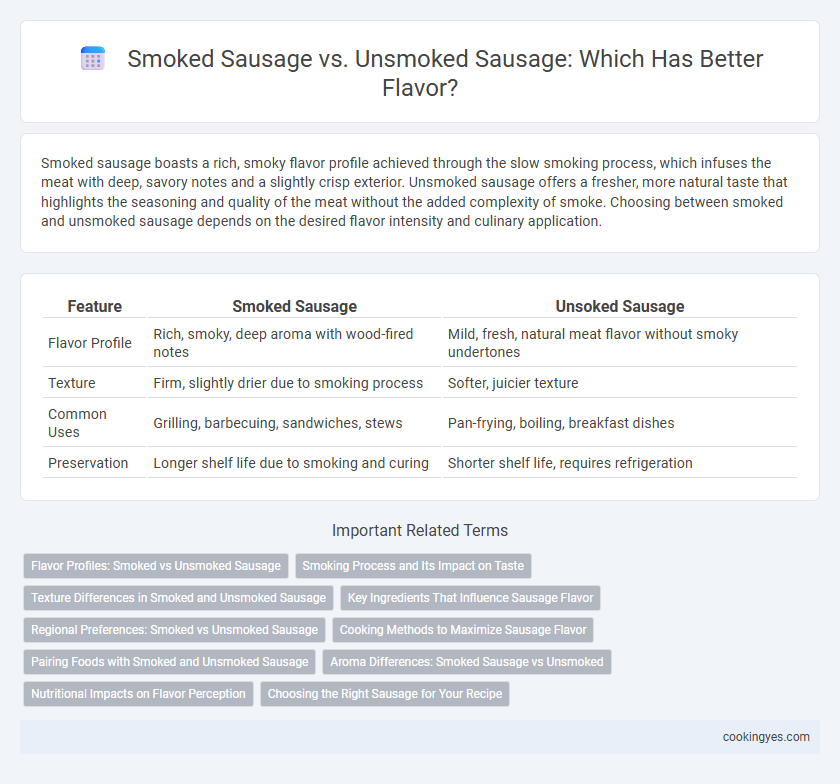Smoked sausage boasts a rich, smoky flavor profile achieved through the slow smoking process, which infuses the meat with deep, savory notes and a slightly crisp exterior. Unsmoked sausage offers a fresher, more natural taste that highlights the seasoning and quality of the meat without the added complexity of smoke. Choosing between smoked and unsmoked sausage depends on the desired flavor intensity and culinary application.
Table of Comparison
| Feature | Smoked Sausage | Unsoked Sausage |
|---|---|---|
| Flavor Profile | Rich, smoky, deep aroma with wood-fired notes | Mild, fresh, natural meat flavor without smoky undertones |
| Texture | Firm, slightly drier due to smoking process | Softer, juicier texture |
| Common Uses | Grilling, barbecuing, sandwiches, stews | Pan-frying, boiling, breakfast dishes |
| Preservation | Longer shelf life due to smoking and curing | Shorter shelf life, requires refrigeration |
Flavor Profiles: Smoked vs Unsmoked Sausage
Smoked sausage offers a rich, deep flavor profile characterized by smoky, savory notes and a slightly firm texture due to the smoking process. Unsmoked sausage delivers a fresher, milder taste that highlights the natural spices and herbs without the complexity of smoke. The choice between smoked and unsmoked sausages depends on the desired intensity and aroma, with smoked varieties providing a robust, charred essence and unsmoked options maintaining a clean, pure meat flavor.
Smoking Process and Its Impact on Taste
The smoking process infuses smoked sausage with complex layers of flavor, including rich, smoky, and slightly sweet notes derived from the type of wood used, such as hickory or applewood. Unsmoked sausage, on the other hand, offers a fresher, more natural meat taste that highlights the seasoning blend and the quality of the meat itself. Smoking not only enhances flavor depth but also affects texture by creating a firmer casing and longer shelf life through the curing and drying effects of smoke exposure.
Texture Differences in Smoked and Unsmoked Sausage
Smoked sausage features a firm, dense texture resulting from the cold or hot smoking process that removes moisture and enhances the meat's structure. Unsmoked sausage typically retains a softer, juicier texture due to the absence of drying effects from smoking, allowing the fat and meat to remain more tender. The texture differences impact the mouthfeel significantly, with smoked sausage offering a chewier bite and unsmoked sausage providing a more succulent, tender experience.
Key Ingredients That Influence Sausage Flavor
Smoked sausage derives its distinctive flavor mainly from key ingredients like hardwood smoke, which infuses compounds such as phenols and carbonyls, enhancing its savory and robust taste profile. In contrast, unsmoked sausage relies on spices and herbs like garlic, paprika, and black pepper, which provide fresh and sharp flavor notes without the smoky undertones. The choice of curing agents, fat content, and seasoning blends also play crucial roles in defining the overall flavor intensity of both smoked and unsmoked sausage varieties.
Regional Preferences: Smoked vs Unsmoked Sausage
Smoked sausage holds a stronger presence in regions like the Midwest and South of the United States, where the smoky, rich flavor profile complements traditional barbecue and hearty dishes. In contrast, unsmoked sausage is favored in European countries such as Germany and Italy, where the emphasis lies on fresh, spiced, and natural meat flavors that pair well with lighter, herb-based recipes. Regional culinary traditions and local palates significantly drive the preference for smoked or unsmoked sausage varieties.
Cooking Methods to Maximize Sausage Flavor
Smoked sausage delivers a rich, deep flavor that develops through the slow smoking process, which infuses the meat with wood smoke compounds, enhancing its savory profile. Unsmoked sausage, often highlighted by fresh, vibrant spices and herbs, benefits most from cooking techniques like grilling or pan-searing to caramelize the exterior and lock in juices. For maximum flavor, combine low-and-slow cooking methods with a finishing high-heat sear to create a balance of smokiness, tenderness, and crisp texture in both smoked and unsmoked sausages.
Pairing Foods with Smoked and Unsmoked Sausage
Smoked sausage offers a rich, smoky flavor that pairs exceptionally well with hearty sides like sauerkraut, grilled peppers, and robust cheeses such as aged gouda or sharp cheddar. Unsmoked sausage provides a milder, more versatile taste that complements lighter accompaniments like fresh salads, mustard-based sauces, and soft cheeses like mozzarella or ricotta. Both types enhance dishes when paired with complementary textures and flavors, making the choice dependent on the desired intensity and culinary experience.
Aroma Differences: Smoked Sausage vs Unsmoked
Smoked sausage offers a rich, smoky aroma infused by the smoking process, which imparts deep, woody, and slightly sweet notes that enhance its overall flavor profile. Unsmoked sausage has a fresher, meat-forward scent with subtle spices and herbs, resulting in a cleaner aroma without the intense smokiness. The contrast in aroma significantly influences culinary applications, with smoked sausage providing robustness and complexity, while unsmoked sausage delivers a milder, more delicate fragrance.
Nutritional Impacts on Flavor Perception
Smoked sausage contains phenolic compounds and polycyclic aromatic hydrocarbons from the smoking process, which intensify flavor while contributing to unique antioxidant properties. Unsmoked sausage lacks these compounds, leading to a milder taste profile and potentially lower bioactive nutrient content. The presence of smoke-derived chemicals influences flavor perception by interacting with taste receptors and enhancing the savory, umami experience.
Choosing the Right Sausage for Your Recipe
Smoked sausage delivers a rich, deep flavor profile with hints of wood and spices, ideal for recipes requiring bold, smoky undertones like jambalaya or gumbo. Unsmoked sausage offers a fresher, milder taste that blends seamlessly in dishes where the sausage complements rather than dominates, such as pasta sauces or breakfast scrambles. Selecting between smoked and unsmoked sausages depends on the desired flavor intensity and the overall balance of your recipe.
Smoked sausage vs unsmoked sausage for flavor Infographic

 cookingyes.com
cookingyes.com